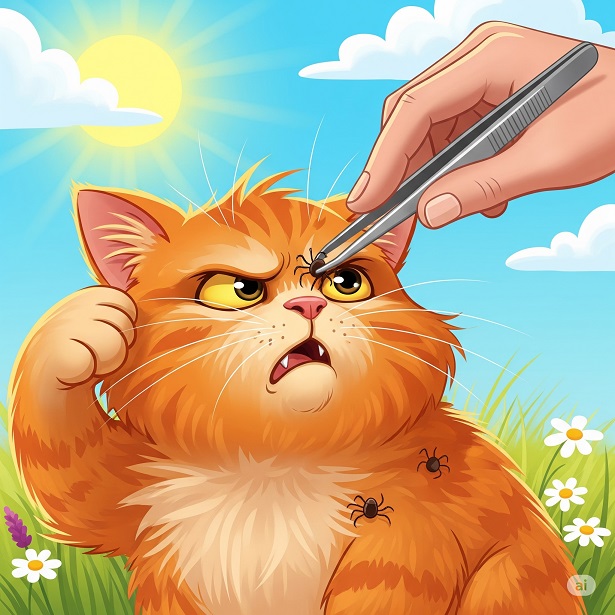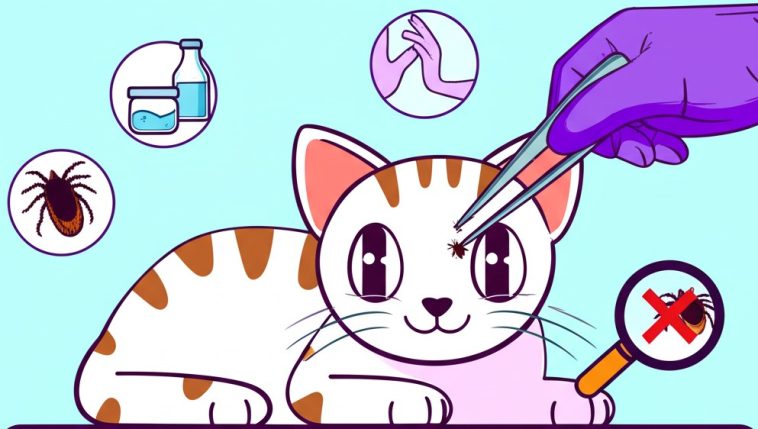Ticks are small, parasitic arachnids that feed on the blood of animals, including cats. They are not just a nuisance; they can transmit serious diseases to our feline friends. Understanding more about ticks and their impact on cats is crucial for every cat owner. These parasites are more than just bloodsuckers—they are vectors for diseases such as Lyme disease, ehrlichiosis, and anaplasmosis. Although less common in cats than in dogs, tick-borne diseases can still pose a significant risk to feline health.
Cats are generally meticulous groomers. However, they might not always be able to remove ticks, especially if they are located in hard-to-reach areas such as the ears, neck, or between the toes. Ticks can cause irritation and discomfort, and if left untreated, the attachment site could become infected. Additionally, ticks can cause anemia in severe infestations due to blood loss.
Preventing tick infestations is essential. By understanding the lifecycle of ticks and their preferred habitats, we can take proactive measures to protect our cats. Ticks thrive in wooded, grassy, or bushy areas, so it is crucial to monitor your cat’s outdoor activities and check them for ticks, especially during the warmer months when ticks are most active.
Signs That Your Cat Has a Tick
Detecting ticks on your cat can be challenging, especially if your feline friend has a thick or long coat. However, being observant and knowing the signs can help you act quickly. One of the first signs is excessive scratching or grooming, particularly in one area. If your cat seems more focused on a specific spot, it might be worth checking for ticks.
Another sign is the presence of small, dark lumps on the skin. These are usually the ticks themselves, which might feel like small bumps when you run your fingers gently over your cat’s body. The head, neck, and ears are common areas where ticks latch on, but they can be found anywhere on your cat’s body. Sometimes, you might notice redness or swelling in the affected area, which can indicate a tick bite.
Behavioral changes in your cat can also be a clue. A tick infestation can lead to lethargy, decreased appetite, and irritability. These symptoms occur as a result of discomfort or the onset of a tick-borne illness. If you notice these signs coupled with unusual bumps or excessive grooming, it’s time to check your cat thoroughly for ticks.

Immediate Steps to Take When You Find a Tick on Your Cat
Finding a tick on your cat can be unsettling, but taking immediate action is crucial. The first step is to remain calm and avoid panicking, as this will help you handle the situation effectively. Ensure you have the necessary tools ready—fine-tipped tweezers or a specialized tick removal tool, gloves, antiseptic, and a small container.
Before attempting to remove the tick, gently restrain your cat to prevent sudden movements that could make the situation more difficult. Wearing gloves, part your cat’s fur around the tick to get a clear view. Using a calm and steady hand, grasp the tick as close to the skin’s surface as possible with the tweezers or removal tool. Pull upward with steady, even pressure, being cautious not to twist or jerk, as this can cause the tick’s mouthparts to break off and remain in the skin.
Once the tick is removed, place it in a container with rubbing alcohol to kill it and preserve it for identification if necessary. This could be useful for your veterinarian if your cat shows symptoms of a tick-borne illness. Clean the bite area with antiseptic to prevent infection. Following these immediate steps can reduce the risk of disease transmission and ensure your cat’s comfort.
Safe Tick Removal Techniques for Cats
Removing a tick from your cat requires precision and care. Using fine-tipped tweezers is a common method, but a tick removal tool can be more effective and reduce the risk of leaving parts of the tick behind. These tools are designed to slide under the tick’s body and remove it in one motion.
When using tweezers, grasp the tick as close to your cat’s skin as possible. This ensures that you remove the entire tick, including its head and mouthparts. Pull the tick out with a straight, steady motion. Avoid twisting or squeezing the tick, as this can lead to regurgitation of its stomach contents into your cat’s bloodstream, increasing the risk of infection.
Another effective method is to use a tick removal tool, which often resembles a small pry bar. Slide the tool under the tick and gently lift it away from the skin. This method minimizes the risk of leaving any part of the tick embedded. After removal, clean the bite area with antiseptic and keep an eye on it for signs of infection, such as redness or swelling.
Aftercare: What to Do Following Tick Removal

Once the tick is successfully removed, proper aftercare is essential to ensure your cat’s health and comfort. Start by cleaning the bite site with a mild antiseptic to prevent infection. Keep an eye on the area for the next few days for any signs of irritation or infection. Redness, swelling, or pus could indicate an infection, and it’s wise to consult a veterinarian if these symptoms persist.
Monitor your cat closely for any unusual behavior or symptoms of illness, such as lethargy, fever, or loss of appetite. These could be signs of a tick-borne disease. If you notice any of these symptoms, contact your veterinarian immediately. Early detection and treatment are crucial for managing these infections effectively.
Finally, take measures to prevent future tick infestations. Regularly inspect your cat for ticks, especially after spending time outdoors. Consider using veterinarian-recommended tick prevention products to reduce the likelihood of ticks attaching to your cat. Your veterinarian can provide guidance on the best products for your pet’s specific needs.
Preventative Measures to Keep Ticks Away from Your Cat
Preventing ticks from latching onto your cat is the best strategy to avoid the complications they bring. Begin by limiting your cat’s exposure to areas where ticks are prevalent, such as woods, tall grasses, and bushy areas. If your cat ventures outdoors, check them thoroughly before they come back inside.
Regular grooming and tick checks are essential. Run a fine-toothed comb through your cat’s fur to catch any ticks before they have a chance to attach and feed. Using a tick comb can be particularly effective for long-haired cats. Additionally, keeping your yard tidy by regularly mowing the lawn and removing leaf litter can reduce the tick population around your home.
Consider consulting with your veterinarian about tick prevention products. Options include topical treatments, collars, or oral medications designed to repel or kill ticks on contact. Ensure you choose products specifically formulated for cats, as some treatments intended for dogs can be harmful to felines. Preventative measures not only protect your cat but also contribute to a tick-free living environment.
When to Seek Veterinary Assistance
While many tick encounters can be managed at home, there are times when veterinary assistance is necessary. If you’re unable to remove the tick completely, or if part of the tick remains embedded, consult your veterinarian. They can safely remove any remaining parts and treat the area to prevent infection.
If your cat shows signs of illness, such as high fever, unexplained lethargy, or loss of appetite, after tick exposure, seek veterinary care promptly. These symptoms could indicate a tick-borne disease that requires professional medical intervention. Early diagnosis and treatment are crucial for a positive outcome.
Additionally, if your cat experiences a severe reaction to a tick bite, such as swelling, difficulty breathing, or other signs of an allergic reaction, it’s important to get them to a veterinary clinic immediately. These situations can be life-threatening and require prompt medical attention.
Common Myths About Ticks and Cats
There are several myths surrounding ticks and cats that can lead to misinformation and improper care. One common myth is that cats are immune to tick-borne diseases. While cats are less susceptible than dogs, they can still contract illnesses from ticks, making prevention and monitoring important.
Another misconception is that ticks only pose a threat in rural or wooded areas. In reality, ticks can be found in urban settings, particularly in areas with vegetation or where wildlife is present. This means that even city-dwelling cats are at risk and should be checked regularly for ticks.
Finally, many believe that all ticks can be removed using home remedies like petroleum jelly or nail polish. These methods are ineffective and can cause harm, as they may irritate the tick, increasing the risk of disease transmission. Always use proper tick removal techniques to ensure the safety and health of your cat.
The Importance of Regular Tick Checks
Regular tick checks are a simple yet crucial practice in keeping your cat healthy. Inspecting your cat for ticks should become part of your routine, especially after they’ve been outside. This practice not only helps in early detection but also reduces the risk of ticks transmitting diseases.
To conduct a thorough tick check, gently run your hands over your cat’s body, paying special attention to areas like the head, neck, ears, and between the toes. If you feel any small bumps, part the fur to check for ticks. Regular grooming sessions can also serve as an opportunity to check for ticks and maintain your cat’s overall health and hygiene.
Incorporating regular tick checks into your routine demonstrates proactive pet care and can prevent many of the complications associated with tick infestations. By staying vigilant, you can ensure a healthier, happier life for your feline friend.
Conclusion: Keeping Your Cat Tick-Free
Keeping your cat tick-free requires vigilance, regular checks, and preventive measures. Understanding the risks associated with ticks and their impact on your cat’s health is essential for effective management and prevention. By following the outlined steps—from immediate actions upon finding a tick to safe removal techniques and aftercare—you can minimize the risk of tick-borne diseases.
Incorporate preventative strategies, such as limiting outdoor exposure, grooming, and using veterinarian-approved tick prevention products. Regular veterinary check-ups also play a crucial role in maintaining your cat’s health and catching any potential tick-related issues early.
For cat owners seeking to keep their pets safe and healthy, consider consulting with your veterinarian for personalized advice and recommendations. By staying informed and proactive, you can create a safer environment for your feline companion and enjoy worry-free moments together.If you’re concerned about ticks and your cat’s health, don’t hesitate to reach out to your veterinarian for more information on the best preventative measures. Stay proactive and ensure your beloved pet remains tick-free and happy!

